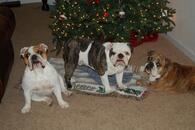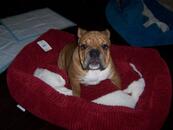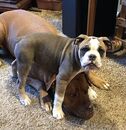[*=center]
I'm Jun 27, 2017
HOT SPOTS — DIAGNOSIS AND TREATMENT THE NATURAL WAY
Spine and muscle injury can cause hot spotsHOT SPOTS — DIAGNOSIS AND TREATMENT THE NATURAL WAY
By Dr. Peter Dobias, DVM
In health-knowledge
If you have ever seen a dog dressed in a T-shirt laced up the back or another one looking like a punk with bald spots shaved all over his body, his owner isn't necessarily an eccentric dog person. The poor pooch may be dressed or shaved because of hot spots.
Depending on what hemisphere you are in, summer may be in full swing and hot spots are likely to be a hot topic under the even hotter summer sun. It is also one of the most misunderstood problems under the sun.
Things often are not what they appear to be
For years, I too lived in oblivion, believing that hot spots were the result of hot weather, swimming and scratching and fleas may be in the equation too. Frequently, a dog with hot spots is pronounced allergic and put on drugs. First antibiotics and antihistamines, then steroids, which usually unleash the nasty dragon of side-effects, such as liver disease, obesity, muscle weakness, excessive thirst and urination, adrenal gland problems and believe it or not, usually more itching.
HOT SPOT ORIGIN
Lets first look at what hot spots are on the surface. They are a superficial inflammation and bacterial infection of the top layer of the skin, or in medical terms, surface pyoderma.
At the beginning of my veterinary career I was prescribing antibiotics and antihistamines and tried to stay clear of steroids. All the books said the same thing. Hot spots are a form of skin infection that has to be treated with antibiotics and steroids.
Most of the time the problems got better but came back later. That was why I started to look at the unique pattern of the skin lesion distribution and realized that these skin lesions usually appeared in very specific areas of the body.
Sometimes hot spots are around the neck or head, sometimes on the feet or the chest, torso, hind legs and abdomen.
Often, I observed that in most cases the muscles underlying the hotspot region were sore, suggesting a local muscle injury, sprain or strain. In other cases, the hot spot location corresponded neurologically to a particular spinal segment that was reactive to touch or immobile. It appeared energy stagnation is the main underlying cause of hotspots.
Here are some examples of how the location of hot spots can relate to a spinal location:
- Cervical spine = Forepaw hot spots or licking.
- Cranial thoracic and mid-thoracic spine = forearm licking, shoulder and armpit hot spots or scratching.
- Thoracic spine = hotspots and skin lesions on the chest.
- Cranial lumbar spine = Abdominal skin lesions.
- Caudal lumbar = hind legs and groin and genital region.
- Tail base = Anal gland abscesses, anal region.

Closer look
To simplify this phenomenon, imagine that the tight muscles cause lack of nourishment to the adjacent region. It can be compared to a watering system where one hose gets kinked causing a lack of water flowing to one garden bed. What are the results? The plants would not thrive.
When it comes to hot spots, lack of energy and blood flow to the skin makes it more prone to rashes and infections and local muscle pain. Dogs scratch the area and the less resistant skin becomes inflamed. Dogs often lick the affected area either because of a pins and needles sensation that radiates from the congested spine or sometimes they simply try to massage the affected muscles by licking.
If your dog suffers from hotspots, go through the following process:
- Examine the spine and relate the hotspot location to the related spinal segment. (See relationships of spine and what area it supplies in the green section above)
- Push down on both sides of the spine and note any signs of discomfort to touch, heat or skin twitching. These are all signals of decreased spinal energy flow, injury or congestion.
- In this case, you need to find either a good, gentle animal chiropractor, physiotherapist, acupuncturist or IMS (intramuscular needle stimulation) practitioner to treat the area. Please contact us if you are looking for someone in the Vancouver area, there are several practitioners that may be suitable.
- In severe recurrent hot spot cases, back X-rays may be needed to determine the degree of bone changes around the vertebrae.
- The more chronic changes, the more frequent and longer term the treatment needs to be. The fewer changes, the better prognosis.
- Assess the size and location of the hotspot.
- If possible, examine the surrounding muscles for pain, swelling, heat and other signs of injury.
- Clip all hair in and around this area if possible. If your pet is too sensitive to touch, use an ice pack to numb the region out.
- Sometimes a sedation or topical anesthesia may be needed.
- FROM THE HEALING STORE
- If the skin appears sore and very crusty, use a face cloth or gauze to soak and soften the scabbing. Gently wash the whole scab off and continue doing so for two to three days.
- Thick crusty scabs harbor bacteria and delay healing.
- Dry the area gently and spray on Herbal Skin Spray two to three times daily for two to four days.
- Thin scab formation is usually a good sign of healing.
- Provide the body with essential supplements and good raw and natural food to ensure good healing.
- What to do if the hotspot reoccurs or doesn’t heal?
- Re-examine the spine and the surrounding muscle
- Make sure that your dog doesn’t overdo activities like sprinting, swimming, ball retrieving, running behind a bike. These can be aggravating factors.
- If the spine continues to be sore, check with your practitioner or ask for a second opinion if unsure.
- Get back X-rays done to check for chronic changes - disc disease, arthritis, and spondylosis.
- If they are present, put your dog on mobility and joint support such as Glyco-Flex.
- The more chronic the injury is, the longer treatment takes. Some patients need a regular maintenance treatment to prevent hot spot recurrence.
- Remember that other causes, such as hormonal issues, food allergies or fungal disease, which are fairly rare, can be the root of the problem.
- Inappropriate use of collars may also be at fault (see more here)
- A word or two about antibiotics in the case of hot spots
- In most situations, antibiotics are not needed if the underlying cause is addressed.
- Bacteria on the skin is generally opportunistic and spreads only if the skin in the area is “malnourished” weakened or traumatized by scratching.
- It is extremely unlikely for hot spot infections to spread systemically.
- Most of the time, antibiotics improve the situation temporarily, but will not resolve the primary cause.
- In rare cases, antibiotics may be needed as a temporary measure.
These preparations often leave permanent traces of their effect. They reduce the patient's self-healing ability and block the effect of homeopathic remedies. In the long run, they may cause permanent damage and incurable disease.
Steroids like prednisone or topical creams, such as Panalog, Surolan or Otomax, reduce the inflammation of the skin and the injured muscles and give temporary relief.
Topical disinfectants like chlorhexidine or hydrogen peroxide?
I do not recommend these because they are not exactly friendly to the growth of new skin cells and generally slow down the healing process.
You can make a difference
Now that you know what hot spots really mean, you can be the canine ambassador for all those dogs who suffer unnecessarily. If you see the dog in a T-shirt or shaven like a punk, perhaps stop by and share what you just learned. You can make a whole world of difference.






